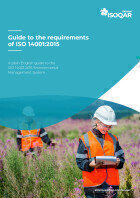Health & Safety
Guide to the requirements of ISO 14001:2015
Nov 07 2019
Author: Alcumus group on behalf of Alcumus
Many people new to management systems are under the impression that an ISO standard is a set of rules that dictates how an organisation should go about its business. That is not correct.
An ISO standard is the document which contains a set of requirements (with some occasional guidance) for the framework of your management system. It is not a set of procedures and targets - they are for you to establish in a way which is relevant to your organisation and the context in which you operate.
If you’ve never looked at an ISO standard before, it may appear daunting. That’s a lot to do with the fact that a standard has to be written in a way that applies to all organisations of every size, in every sector, in every location around the world. So occasionally an ISO standard can seem vague, and sometimes lapse into jargon.
This guide looks at all the clauses and main sub clauses and describes them in plain English. You will also find practical advice on measures you might want to consider implementing in your organisation. You should read this document alongside the standard.
This guide doesn’t go through the standard line by line. ISO standards sometimes artificially separate important topics but in the real world you won’t find it works like that in your workplace. So, this guide takes a more holistic approach to minimise the need to jump back and forth.
This guide is not a substitute for the standard itself nor for the expert guidance of a professional, but it will help demystify some of the more difficult-to-grasp aspects of ISO 14001.
You usually want to maximise everything to do with your organisation, like brand awareness, revenue and profits. But when it comes to the environment, you want to minimise your impact. The reasons for wanting to do this are many and varied. There’s now much greater social, political and regulatory pressure to do so. Customers are keen to work with suppliers that have sound environmental credentials. Whatever your motivation, one of the best ways to achieve your environmental goals is with ISO 14001:2015 - the international standard for an Environmental Management System (EMS).
In a nutshell, an Environmental Management System certified to ISO 14001:2015 (usually just referred to as ISO 14001) can help your organisation identify, manage, monitor and control environmental issues to improve what’s known as your ‘environmental performance’. This is largely achieved through
more efficient use of resources, reduced waste and compliance with regulations. The implementation of a certified Environmental Management System (EMS) will not guarantee compliance with legislation nor give you immunity from prosecution. However, it does provide a framework for you to minimise the risks of breaches of legislation due to the better control of processes. Risk is further reduced as a result of the increased awareness and knowledge among employees that comes from implementing and maintaining the system. ISO 14001 is good for the environment and good for your business.
>>This Guide includes images and graphs that can only be seen once the document is Unlocked, and downloaded<<
Digital Edition
AET 28.2 April/May 2024
May 2024
Business News - Teledyne Marine expands with the acquisition of Valeport - Signal partners with gas analysis experts in Korea Air Monitoring - Continuous Fine Particulate Emission Monitor...
View all digital editions
Events
Jul 30 2024 Jakarta, Indonesia
China Energy Summit & Exhibition
Jul 31 2024 Beijing, China
2024 Beijing International Coal & Mining Exhibition
Aug 07 2024 Beijing, China
IWA World Water Congress & Exhibition
Aug 11 2024 Toronto, Canada
Aug 25 2024 Stockholm, Sweden and online






.jpg)








